Trending News
17 October, 2024
8.3°C New York

Back in my day, Facebook was cool. Gaggles of middle schoolers trolled the local mall, where we would stop into the Apple Store, find an early MacBook Pro, and take dozens of pictures with gaudy Photo Booth filters to post on Facebook. Sometimes, other teens would forget to log out of their accounts, and we would post something like “i just pooped” before signing into our own accounts.
This isn’t the case anymore. In 2014, the Pew Research Center estimated that 71% of U.S. teens used Facebook; as of 2022, that percentage dropped to 32%, then slightly increased to 33% last year. Other studies from Edison Research have shown the same trend. Though Meta is reticent to share much demographic information about its user base, the app’s head, Tom Alison, said that there are 40 million daily active users in the U.S. and Canada between the ages of 18 and 29.
Facebook remained central to my social experiences in high school and college. If you weren’t on Facebook, you wouldn’t get invited to parties, and you wouldn’t know when any student clubs were holding meetings. In the 2010s, deleting Facebook would have been a disaster for my social life. Now if I woke up one day to find that my Facebook account had been deleted, it would be a minor inconvenience.
My experience isn’t unique. So, as Meta tries to rekindle the flame between Facebook and socially anxious youths, the company released a blog post Wednesday titled, “Navigating your 20s with Facebook.”
“Your twenties are a decade full of transitions, from graduating college, moving to new cities, starting new jobs and living on your own for the first time. It can be a hectic (and fun) decade, and Facebook is here to help,” the post says.
Do twentysomethings read the Facebook blog? (Does anyone other than journalists read the Facebook blog?) If they do, they’ll learn that you can meet new friends in groups like “NYC Brunch Squad” or “People We Meet in Book Club,” a virtual book club with almost 20,000 members. (It’s not necessarily a group for meeting fellow readers, but rather, the title is probably referencing a novel by best-selling romance writer Emily Henry.)
Meta’s blog also suggests that in your 20s, you could meet the love of your life on Facebook Dating. I don’t know about that, but then again, I’m a single twentysomething who has never used Facebook Dating, so maybe they have a point.
What Facebook does get right about Gen Z is that Facebook Marketplace is the new Craigslist. It’s trendy among young people — whether due to environmental consciousness or budget constraints — to shop secondhand. It will never be the safest decision to meet a stranger online to buy their old couch, but if you can at least view that stranger’s Facebook profile, it could be easier to verify that they’re legit. They might even have mutual friends with you, whereas on Craigslist, you’re staring in the face of a private relay email with no personal information.
Facebook marketplace is popular enough that rising Gen Z social app Fizz wants to undercut it. The anonymous, college-centric social platform recently added a marketplace to its app with this idea in mind.
“There’s that kind of stigma around, like, if I sell something on Craigslist, I might get kidnapped,” Fizz founder Teddy Solomon told TechCrunch. “And Facebook marketplace … Gen Z is not using Facebook,” he said.
As Facebook faded out of style, our social architecture shifted. I find out about concerts in my area through Instagram posts or promotional emails from local venues. My friends send invitations to birthday dinners via Partiful, an SMS-based party-planning app backed by a16z, or they just post kitschy Canva graphics to their Close Friends story.
Now 20 years old, Facebook is trying to stay relevant. According to Axios, the platform hosted an event with young creators focused on looking forward to Facebook’s next 20 years. Facebook gave creators pamphlets declaring, “We are not your mom’s Facebook.” Instead, the app described itself as “a hub for all things culturally happening in the platform’s underground.”
This feels like a stretch. Then again, Abercrombie, which reigned supreme about 20 years ago, has re-emerged into the zeitgeist, with its stock up 900%. Even Mark Zuckerberg has managed a miraculous rebrand. Maybe one day, Facebook will be cool again, too.
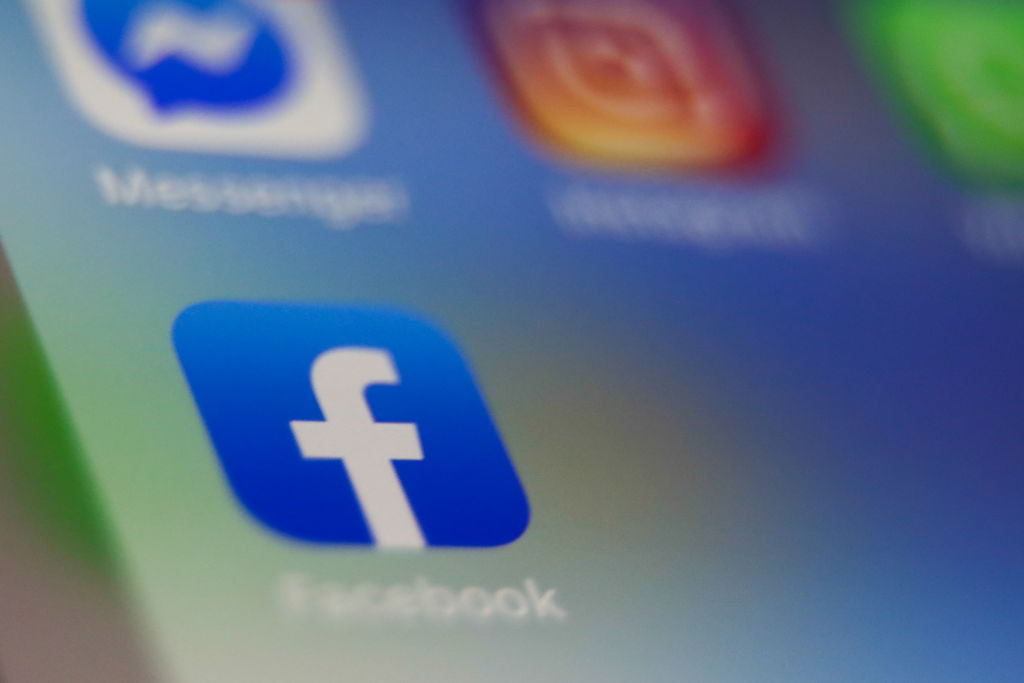
The recent surprise announcement that Meta will soon be shutting down its Facebook Groups API is throwing some businesses and social media marketers into disarray.
On January 23, Meta announced the release of its Facebook Graph API v19.0, which included the news that the company would be deprecating its existing Facebook Groups API. The latter, which is used by developers and businesses to schedule posts to Facebook Groups, will be removed within 90 days, Meta said. This includes all the Permissions and Reviewable Features associated with the API, it also noted.
Meta explained that a major use case for the API was a feature that allowed developers to privately reply in Facebook Groups. For example, a small business that wanted to send a single message to a person who posted on their Facebook Group or who had commented in the group could be messaged through the API. However, Meta said that another change in the new v19.0 API would enable this feature, without the need for the Groups API.
But developers told TechCrunch that the shutdown of the API would cause problems for companies that offer solutions to customers who want to schedule and automate their social media posts. For example, explained Adam Peterson, the CEO of VipeCloud, which provides a suite of tools for scheduling social media posts, the API’s closure will have a “noticeable impact” on his business, as about 8% of his total revenue is on the chopping block. His company serves some 5,000 Facebook accounts, primarily those belonging to female entrepreneurs, he noted.
These customers rely on VipeCloud’s access to Facebook’s APIs to publish publicly to their Facebook Pages, but also post privately to Groups to communicate with their team. The private groups are used as something of a Slack alternative by these small businesses, he says.
“Every single one of our customers is freaking out,” says Peterson.
Other customers of the Groups API may rely on automations that are scheduled by the business’s agency partners, some of which will be disproportionally impacted by the API’s closure.
Peterson explains that customers often rely on agencies to handle various aspects of their posting, like team building or team motivation. “Those agencies, this is their entire business. This is their livelihood,” he adds.
The move also impacts VipeCloud’s competitors, often non-venture-funded companies that build market-specific services and whose revenue may be in the single-digit millions to low double-digit millions.
“Some of these other companies — they’re going to be killed,” notes Peterson. “And that’s just never fun to watch, even if we compete with them. You’d rather win on service or product or something,” he continues. “This is platform risk in real time.”
A company by the name of PostMyParty, which helps social sellers and others schedule and automate online parties, says the API’s closure will put the company out of business.
“I will lose seven years of work and over 10,000 customers,” owner Daniel Burge tells TechCrunch. “A multimillion-dollar loss. Let alone the impact on all of our customers that rely on our software,” he adds.
PostMyParty is used by small micro-businesses, including health and fitness coaches who do online boot camps in Facebook Groups, work-at-home moms engaged in social sales and others with coaching groups or customer groups, says Burge.
The entrepreneur pointed out this is not the first time Meta has done something like this.
“A number of years ago [Meta] abruptly ended their Events API, with zero notice,” Burge says. “We just came in one day and everything was broken, we had thousands of support requests open from our customers and it almost destroyed our business that time as well.”
What’s more, developers tell us that Meta’s motivation behind the API’s shutdown is unclear. On the one hand, it could be that Facebook Groups don’t generate ad revenue and the shutdown of the API will leave developers without a workaround. But Meta hasn’t clarified if that’s the case. Instead, Meta’s blog post only mentioned one use case that would be addressed through the new v.19.0 API.
Maurice W. Evans, a Meta Certified Community Manager, believes the move will pose challenges for small businesses, developers and digital markets, but also represents a “pivotal shift in Meta’s operational philosophy.”
“The removal of third-party access to Facebook Groups could significantly alter the digital landscape, creating both hurdles and opportunities for community managers and businesses alike. As a Meta Certified Community Manager, I’ve seen firsthand the value these tools bring to fostering vibrant, engaged online communities. This change underscores the need for adaptability and innovation in our strategies,” Evans tells TechCrunch.
Elsewhere on social media, website design firm Archer Web Design called the news of the API’s closure “devastating” and said that “businesses and social media marketers will be thrown into the stone age with this!,” they wrote in a post on X, formerly Twitter.
On Meta’s forum for developers, one developer says they’re “pretty shocked” by the company’s announcement, noting their app relies on the Groups API and will essentially no longer work when the shutdown occurs.
Others are frustrated that Meta hasn’t clearly explained if posting on Groups will be done with a Page Access token going forward, as the way the announcement is worded it seems that part is only relevant for those posting private replies, not posting to the group as a whole. Burge, for instance, wonders if the whole thing could just be some messaging mistake — like Meta perhaps forgot to include the part where it was going to note what its new solution would be.
There is concern, however, that Meta is deprioritizing developers’ interests having recently shut down its developer bug portal as well.
Reps from Facebook haven’t replied to the developers’ comments in its forums (as of the time of writing), leaving everyone in the dark.
Laments another developer in the forum, “it affects my ongoing projects and projects that will be launched soon. I don’t know what to do.”
This story is developing. Meta has been asked for comment and we’ll update as we know more.
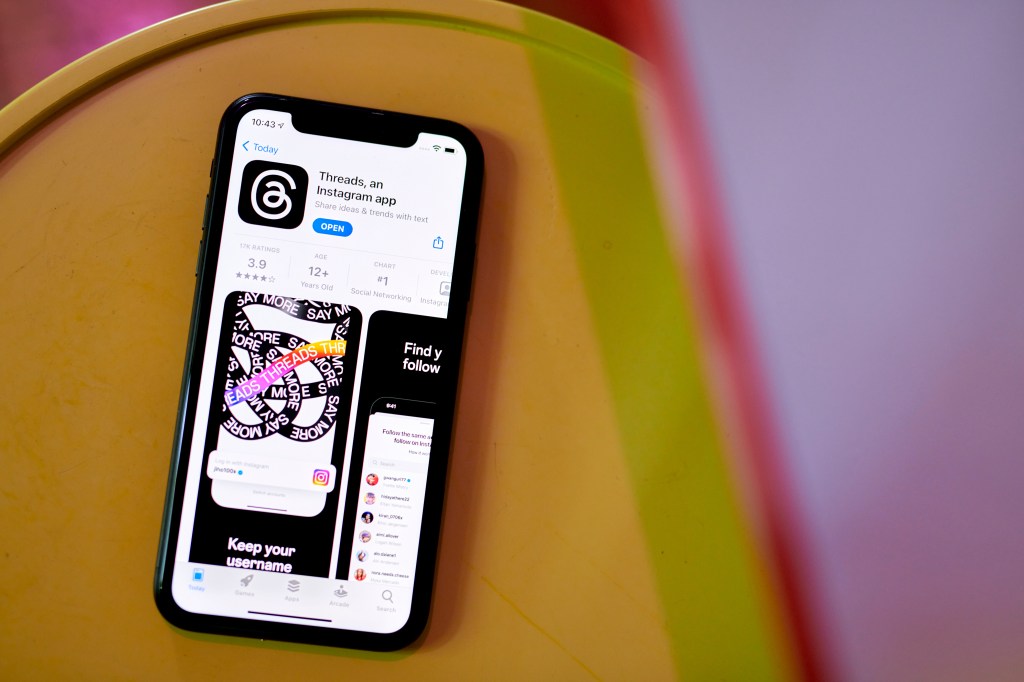
Threads may be about to get another big boost from parent company Meta…at least in terms of sources of new content. The company has been spotted testing a cross-posting feature that would allow Facebook users to post to both platforms at the same time, using the same feature that was originally available for cross-posting from Facebook to Instagram.
The company confirmed a limited test has begun, but is restricted to iOS and does not include the EU. The feature will allow users to share both text and link posts from Facebook to Threads, a rep for Meta said.
The addition could help content creators who regularly post photos or other media along with text updates from the hassles of having to post in multiple places. It also ties Threads more closely to Meta’s larger app ecosystem, which could potentially give Threads’ app a boost, if the test rolls out more broadly. Today, Meta’s family of apps reaches 3.98 billion users. Even if only a sliver of those on Facebook used the cross-posting feature for Threads, it could still dramatically increase the number of posts available on the app.
Facebook added the option to cross-post to Instagram in 2021, after earlier offering the ability to cross-post Stories between the two platforms. With last summer’s launch of its Twitter/X competitor, Threads, the company leveraged its other, larger social networks to rapidly grow the new service’s user base.
Initially, new Threads users were automatically connected with others they knew or followed on Instagram, allowing the network to scale quickly after launching, topping a record-setting 100 million users within five days of its arrival, and soon achieving one-fifth of the weekly active user base of Twitter/X. As of Meta’s most recent quarter, Threads reached more than 130 million monthly active users, thanks in part to how the company showcased popular Threads within the main feeds of both Facebook and Instagram.
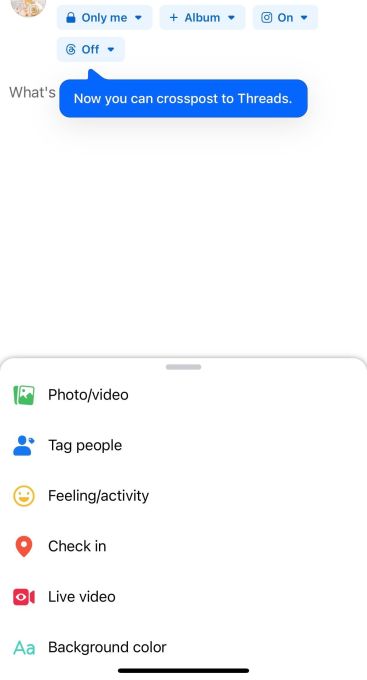
The test of the Facebook cross-posting feature was recently spotted in the wild on Facebook’s iOS app, as in this example here shared by Threads user @whimchic (Ljiljana Grujicic). When she tested the feature, the post was automatically published to both accounts associated with her same profile, but didn’t include any account information from Facebook or a flag that it was cross-posted. The latter could be a concern for someone who uses their full name on Facebook but a more anonymous handle on a more public platform like Threads.
This isn’t the first time Threads has toyed with cross-posting. Earlier, users on Threads were upset to find that their posts were being automatically shared on Facebook and Instagram — where their audiences were different from those who followed them on Threads. Often, users connect with family and friends on Facebook and Instagram but maintain a public persona or talk about their work or political interests on Threads, similar to how they used Twitter. In response to user feedback, Meta soon added an option that allowed users to turn off automatic sharing by default and the backlash died down.
Cross-posting wasn’t the only area where Facebook is testing new features. Grujicic also shared a photo on LinkedIn that showed a test of a “Write with AI” writing assistant that could help users craft their posts.
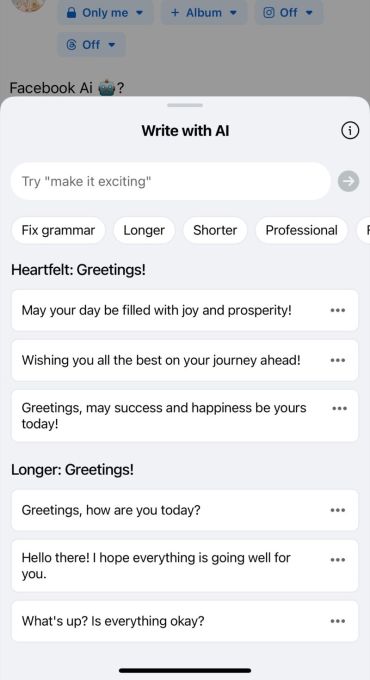

Ina Herlihy believes e-commerce brands are losing out on organic traffic and potential revenue by relying on third-party community sites, like Reddit and Facebook Groups.
As new user acquisition costs increase, in some cases by hundreds of dollars, brands have to care more about increasing retention and organic traffic, Herlihy told TechCrunch via email. By building an onsite community, brands are able to increase that retention and drive more organic traffic because the community is on their own domain.
Herlihy set out in late 2022 to build community software for brands to host communities on their own websites. AddGlow is the result.
“Owned community is the next big marketing channel for the $17 trillion e-commerce market,” Herlihy said. “Brands who want to foster community do so mostly via Facebook Groups, but there are gaps for both customers and brands. For example, customers don’t have context on who is posting. We solve that with detailed user profiles so brands don’t miss out on owning the data and can reduce the number of steps to make a purchase.”
Stealthy social commerce startup taps into Meta roots to create AI-first brand messaging
Here’s how it works: The New York-based startup collects data via profile attributes specified by the brand, for example, skin concern, hair type or favorite type of shoe, so that the brand can personalize the homepage, product description pages, emails and SMS.
In addition, AddGlow integrates with a brand’s catalog so community members can tag products when mentioning them. This allows site visitors to seamlessly add to their cart without leaving the community.
Meanwhile, through an onsite engagement-based loyalty program community members can earn points for completing certain actions, like completing their profile, posting and replying. All of this is customizable by the brand.
The company is still very much in its early stages following a year of product development. It now has $1.7 million in pre-seed funding to boost AddGlow into its next phase, Herlihy said.
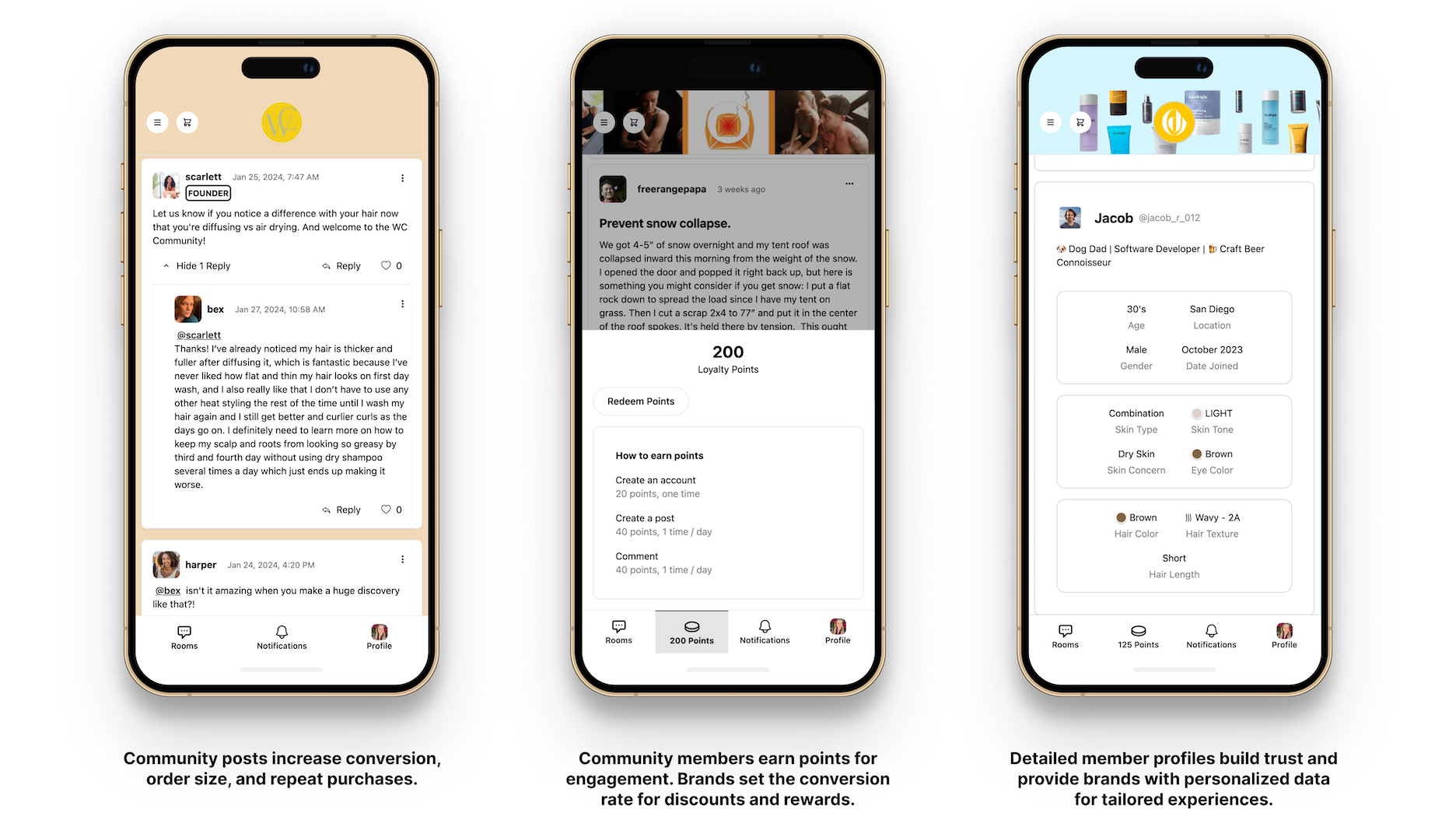
The venture capital process took about two months even though Herlihy is somewhat of a unique founder in this challenging funding environment: A “non-technical solo founder with an idea,” as she described herself.
Stellation Capital and Precursor Ventures co-led the round and were joined by Miles Bird at StoryHouse Ventures and a group of strategic angel investors, including former Walmart executive Jeff Shotts, StockX co-founder Chris Kaufman, former Glossier president Henry Davis, Zumper co-founder and CEO Anthemos Georgiades and Walker & Company Brands founder Tristan Walker.
“I met both Peter Boyce II (Stellation) and Charles Hudson (Precursor) via founder friends,” Herlihy said. “Before and during fundraising I asked tech friends which VCs they were most impressed by for pre-seed founders. Charles’ and Peter’s names came up the most, so I knew I needed them on my cap table.”
The new capital enabled Herlihy to bring on engineers and a designer who had previous experience at brands like Walmart, Nike, eBay, Google and Twitch. After a year focused on product development, AddGlow’s second year will be focused on revenue, Herlihy said.
“We started partnering with smaller brands, and now we’re building additional functionality to support larger brands, too,” Herlihy said. “AddGlow helps give people a sense of belonging. Our goal is to foster a safe space for community members to seek personal advice and build meaningful connections.”
Why the ‘last click’ in e-commerce matters — and how to get it right

In 2016, Facebook launched a secret project designed to intercept and decrypt the network traffic between people using Snapchat’s app and its servers. The goal was to understand users’ behavior and help Facebook compete with Snapchat, according to newly unsealed court documents. Facebook called this “Project Ghostbusters,” in a clear reference to Snapchat’s ghost-like logo.
On Tuesday, a federal court in California released new documents discovered as part of the class action lawsuit between consumers and Meta, Facebook’s parent company.
The newly released documents reveal how Meta tried to gain a competitive advantage over its competitors, including Snapchat and later Amazon and YouTube, by analyzing the network traffic of how its users were interacting with Meta’s competitors. Given these apps’ use of encryption, Facebook needed to develop special technology to get around it.
One of the documents details Facebook’s Project Ghostbusters. The project was part of the company’s In-App Action Panel (IAPP) program, which used a technique for “intercepting and decrypting” encrypted app traffic from users of Snapchat, and later from users of YouTube and Amazon, the consumers’ lawyers wrote in the document.
The document includes internal Facebook emails discussing the project.
“Whenever someone asks a question about Snapchat, the answer is usually that because their traffic is encrypted we have no analytics about them,” Meta chief executive Mark Zuckerberg wrote in an email dated June 9, 2016, which was published as part of the lawsuit. “Given how quickly they’re growing, it seems important to figure out a new way to get reliable analytics about them. Perhaps we need to do panels or write custom software. You should figure out how to do this.”
Facebook’s engineers solution was to use Onavo, a VPN-like service that Facebook acquired in 2013. In 2019, Facebook shut down Onavo after a TechCrunch investigation revealed that Facebook had been secretly paying teenagers to use Onavo so the company could access all of their web activity.
After Zuckerberg’s email, the Onavo team took on the project and a month later proposed a solution: so-called kits that can be installed on iOS and Android that intercept traffic for specific subdomains, “allowing us to read what would otherwise be encrypted traffic so we can measure in-app usage,” read an email from July 2016. “This is a ‘man-in-the-middle’ approach.”
Do you know more about Project Ghostbusters? Or other privacy issues at Facebook? From a non-work device, you can contact Lorenzo Franceschi-Bicchierai securely on Signal at +1 917 257 1382, or via Telegram, Keybase and Wire @lorenzofb, or email. You also can contact TechCrunch via SecureDrop.
A man-in-the-middle attack — nowadays also called adversary-in-the-middle — is an attack where hackers intercept internet traffic flowing from one device to another over a network. When the network traffic is unencrypted, this type of attack allows the hackers to read the data inside, such as usernames, passwords, and other in-app activity.
Given that Snapchat encrypted the traffic between the app and its servers, this network analysis technique was not going to be effective. This is why Facebook engineers proposed using Onavo, which when activated had the advantage of reading all of the device’s network traffic before it got encrypted and sent over the internet.
“We now have the capability to measure detailed in-app activity” from “parsing snapchat [sic] analytics collected from incentivized participants in Onavo’s research program,” read another email.
Later, according to the court documents, Facebook expanded the program to Amazon and YouTube.
Inside Facebook, there wasn’t a consensus on whether Project Ghostbusters was a good idea. Some employees, including Jay Parikh, Facebook’s then-head of infrastructure engineering, and Pedro Canahuati, the then-head of security engineering, expressed their concern.
“I can’t think of a good argument for why this is okay. No security person is ever comfortable with this, no matter what consent we get from the general public. The general public just doesn’t know how this stuff works,” Canahuati wrote in an email, included in the court documents.
In 2020, Sarah Grabert and Maximilian Klein filed a class action lawsuit against Facebook, claiming that the company lied about its data collection activities and exploited the data it “deceptively extracted” from users to identify competitors and then unfairly fight against these new companies.
An Amazon spokesperson declined to comment.
Google, Meta, and Snap did not respond to requests for comment.
This story was updated to correct the link to the discovery documents in the fourth paragraph.
Facebook will shut down its spyware VPN app Onavo
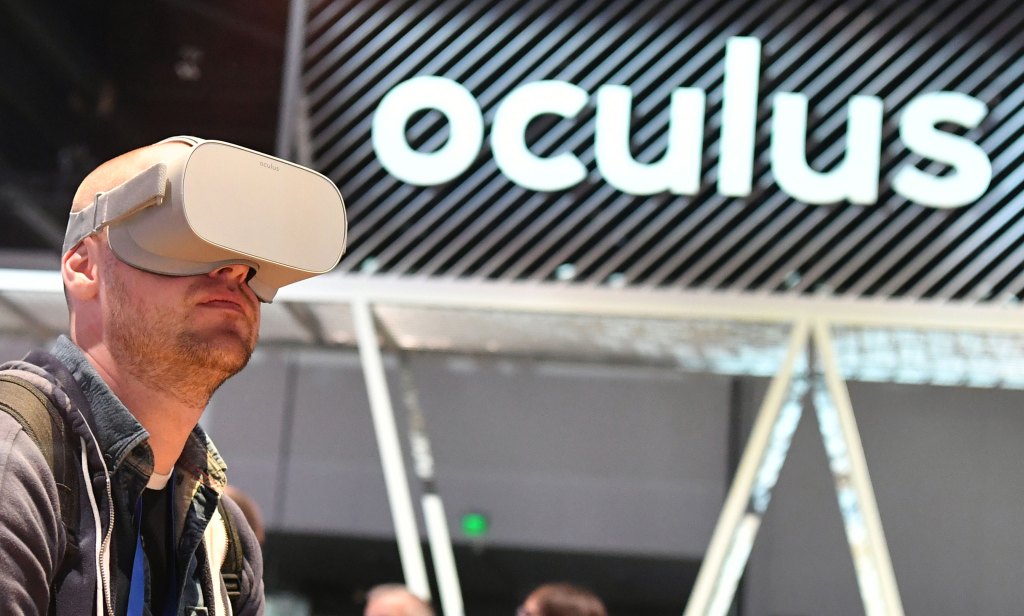
Every year, Time Magazine issues a list of the 200 best inventions of the past 12 months. Frankly, I don’t know how the editors do it. The dirty secret of this job is that true, game-changing inventions rarely cross your desk. In fact, you’re extraordinarily lucky if you average one a year.
Oculus’ Rift prototype felt like just such a device when it first crossed my radar more than a decade ago. More than anything, the system resembled a hastily duct-taped ski mask. It was a remarkable presentation, in hindsight — an all-too-rare glimpse into a plucky entrepreneurial tech spirit. It evokes a flood of romanticized images of Homebrew Computer Club nerds soldering together circuit boards in South Bay garages.
A decade has now passed since Meta (née Facebook) announced plans to acquire the startup for $2 billion. A decade after the deal was announced, it’s safe to say that the VR headset hasn’t changed the world we live in. But there’s always that little-discussed middle ground between transforming the human condition and just being an abject dumpster fire of failure. So, where, as of April 2024, does the Facebook/Oculus deal rank?
“Immersive gaming will be the first, and Oculus already has big plans here that won’t be changing and we hope to accelerate,” Mark Zuckerberg wrote at the time. “After games, we’re going to make Oculus a platform for many other experiences. Imagine enjoying a court side seat at a game, studying in a classroom of students and teachers all over the world or consulting with a doctor face-to-face — just by putting on goggles in your home.”

Facebook’s founder referred to the Oculus Rift as a “new communication platform,” comparing it to computers, the internet and smartphones before it. He suggested that the “dream of science fiction” was now a reality — one that Facebook had suddenly cornered. It’s hard to overstate how transformative Zuckerberg believed the technology to be. It was, after all, the gateway to the metaverse.
Should anyone doubt the company’s commitment to the concept, in late 2021, it rebranded itself as “Meta,” killing off the Oculus brand the same afternoon. Surely social media platforms wouldn’t dominate online discourse forever. They would eventually give way to something wholly new. Except that despite that $500 billion rebrand, Zuckerberg and company never did a particularly good job of defining the metaverse. They simply insisted that it was an exciting thing that you should be excited about.

I suspect that were you to perform a blind poll, the majority of people who are familiar with the term meta would describe something like Second Life, the virtual world that to be on its fifth or sixth life by now. Mark Zuckerberg is probably as guilty as any single person for perpetuating that perception, happily working his hardest to make the company’s Horizon Worlds platform synonymous with conceptions of the metaverse. Remember what a big deal it was when its avatars finally got legs?
So where are we now? It’s complicated, obviously. From a purely financial standpoint (the only language shareholders speak), things are bleak. Between the end of 2020 and the first quarter of 2024, the company’s metaverse division lost $42 billion. That’s roughly 21x the price it paid for Oculus, not adjusting for inflation. That’s a little over one-fourth a Zuckerberg (not adjusted for inflation — i.e., BJJ-related bulking).
Why is Meta hemorrhaging that much money? The simple and cynical answer is, because it can. The corporation made $134 billion in revenue and $39.1 billion in net income last year. That’s not to say that having a division that’s $42 billion in the red over four years doesn’t impact its bottom line, of course. But Facebook believes it’s playing the long game here.

It’s widely believed that Meta sells its Quest headsets at a loss. This is despite the fact that the company has easily the best manufacturing scale in the industry. It doesn’t take an MBA to understand that this is a terrible short-term strategy, but again, Meta believes it’s playing the long game. The end game is getting enough of these devices into people’s hands to reach a critical mass of adoption, word of mouth and developer content. If you can’t do that while turning a profit, well, you gotta spend money to make money, right?
It continues to be a massive bet. How long the company is willing to play the long game here, however, largely comes down to how much patience Meta’s shareholders have. If it can truly saturate the market and corner content, it will be better positioned to capitalize on mixed reality’s hypothetical exponential growth.
It has already edged the competition out of the market and generally sucked the air out of the room. As an HTC Vive exec told me back in February at MWC, “I think Meta has adjusted the market perception of what this technology should cost.” Other companies can’t compete on price and content in the customer space, so the savviest of the bunch have moved over to enterprise, where clients have much deeper pockets.
If you judge the company’s journey in terms how much of the VR headset market it controls, it’s been a wild and unprecedented success. According to IDC, Meta had a 50.2% share as of Q2 2023. Of course, we’re not talking about smartphone figures here. As of early 2023, Meta was estimated to have sold 20 million headsets. At the end of the year, the Quest 2 was still outselling the Quest 3. One part of the Meta thesis has absolutely played out: People are looking for an inexpensive on-ramp to the technology.

When Apple announced the Vision Pro at WWDC 2024, I received a flood of unsolicited comments from VR headset manufacturers all stating they saw the iPhone maker’s headset as validation for the space. You can cynically (and correctly) point out that everyone says some version of that when Apple enters their vertical, and many of them don’t make it out the other side in one piece.
But I concur that Apple throwing its hat in the ring after decades of failed VR attempts does constitute validation. That’s absolutely the case for Meta. Zuckerberg happily used the opportunity to point out that his headsets were (1) significantly less expensive and (2) didn’t require an external battery. Meta also had a large head start in terms of VR-specific content. Naturally, Zuckerberg also insisted that his product was vastly superior in spite of the significantly lower price point.
“It seems like there are a lot of people who just assumed that Vision Pro would be higher quality because it’s Apple and it costs $3,000 more,” he noted in February, “but honestly, I’m pretty surprised that Quest is so much better for the vast majority of things that people use these headsets for, with that price differential.”
Sorry, Zuck, the Vision Pro is the more impressive piece of technology. Whether it’s $3,000 more impressive is a different conversation. What I can tell you right now is that the pricing gulf puts these products into different categories. Apple is targeting business customers at that price point, while Meta is far more committed to democratizing access by — again — losing money on a per-unit basis.
It’s still early days for Vision Pro — and, really, mixed reality in general. If it ever does truly become ubiquitous, it will be the result of countless hard-fought battles. As we mark a decade since the Oculus acquisition, I find myself returning to the above Zuckerberg comment: “Imagine enjoying a courtside seat at a game, studying in a classroom of students and teachers all over the world or consulting with a doctor face-to-face — just by putting on goggles in your home.”
Re-reading this from the vantage point of 2024, it strikes me that he was right about the content, but not necessarily the delivery mechanism. The past four years have dramatically impacted how we interact with each other, the world and day-to-day activities. The pandemic de-stigmatized so many virtual activities. But for the time being, no headsets are required.

Facebook and Instagram are under formal investigation in the European Union over child protection concerns, the Commission announced Thursday. The proceedings follow a raft of requests for information to parent entity Meta since the bloc’s online governance regime, the Digital Services Act (DSA), started applying last August.
The development could be significant as the formal proceedings unlock additional investigatory powers for EU enforcers, such as the ability to conduct office inspections or apply interim measures. Penalties for any confirmed breaches of the DSA could reach up to 6% of Meta’s global annual turnover.
Meta’s two social networks are designated as very large online platforms (VLOPs) under the DSA. This means the company faces an extra set of rules — overseen by the EU directly — requiring it to assess and mitigate systemic risks on Facebook and Instagram, including in areas like minors’ mental health.
In a briefing with journalists, senior Commission officials said they suspect Meta of failing to properly assess and mitigate risks affecting children.
They particularly highlighted concerns about addictive design on its social networks, and what they referred to as a “rabbit hole effect,” where a minor watching one video may be pushed to view more similar content as a result of the platforms’ algorithmic content recommendation engines.
Commission officials gave examples of depression content, or content that promotes an unhealthy body image, as types of content that could have negative impacts on minors’ mental health.
They are also concerned that the age assurance methods Meta uses may be too easy for kids to circumvent.
“One of the underlying questions of all of these grievances is how can we be sure who accesses the service and how effective are the age gates — particularly for avoiding that underage users access the service,” said a senior Commission official briefing press today on background. “This is part of our investigation now to check the effectiveness of the measures that Meta has put in place in this regard as well.”
In all, the EU suspects Meta of infringing DSA Articles 28, 34, and 35. The Commission will now carry out an in-depth investigation of the two platforms’ approach to child protection.
The EU opened a similar probe into addictive design concerns on video sharing social network TikTok last month.
It also already opened two DSA investigations on Meta’s social networks: Last month the Commission said it would investigate separate concerns related to Facebook’s and Instagram’s approach to election integrity.
Reached for a response to the latest EU investigations, a Meta spokesperson emailed us this statement: “We want young people to have safe, age-appropriate experiences online and have spent a decade developing more than 50 tools and policies designed to protect them. This is a challenge the whole industry is facing, and we look forward to sharing details of our work with the European Commission.”
The company also told us its approach to verifying the age of users of the two social networks relies on a combination of self-declared age and AI assessments to try to detect kids who may be lying about their age. Additionally, it said it allows people to report suspected underage accounts, adding that it trains its content reviewers to flag accounts that may be used by underage minors.
Users who are under 18 and attempt to edit their age on its platforms will be challenged to choose and submit to an age verification test, per Meta — however, the company did not specify which age verification checks it offers. But it claimed that internal tests of the efficacy of its approach indicate it’s working to prevent minors from accessing age-appropriate experiences. Since instigating the checks, Meta said it has been able to stop 96% of teens who attempted to edit their birthdays from under 18 to over 18 on Instagram from doing so.
This report was updated with comment from Meta
EU opens probe of TikTok Lite, citing concerns about addictive design